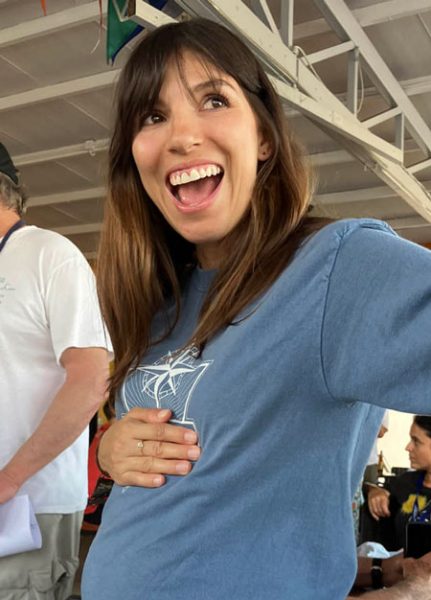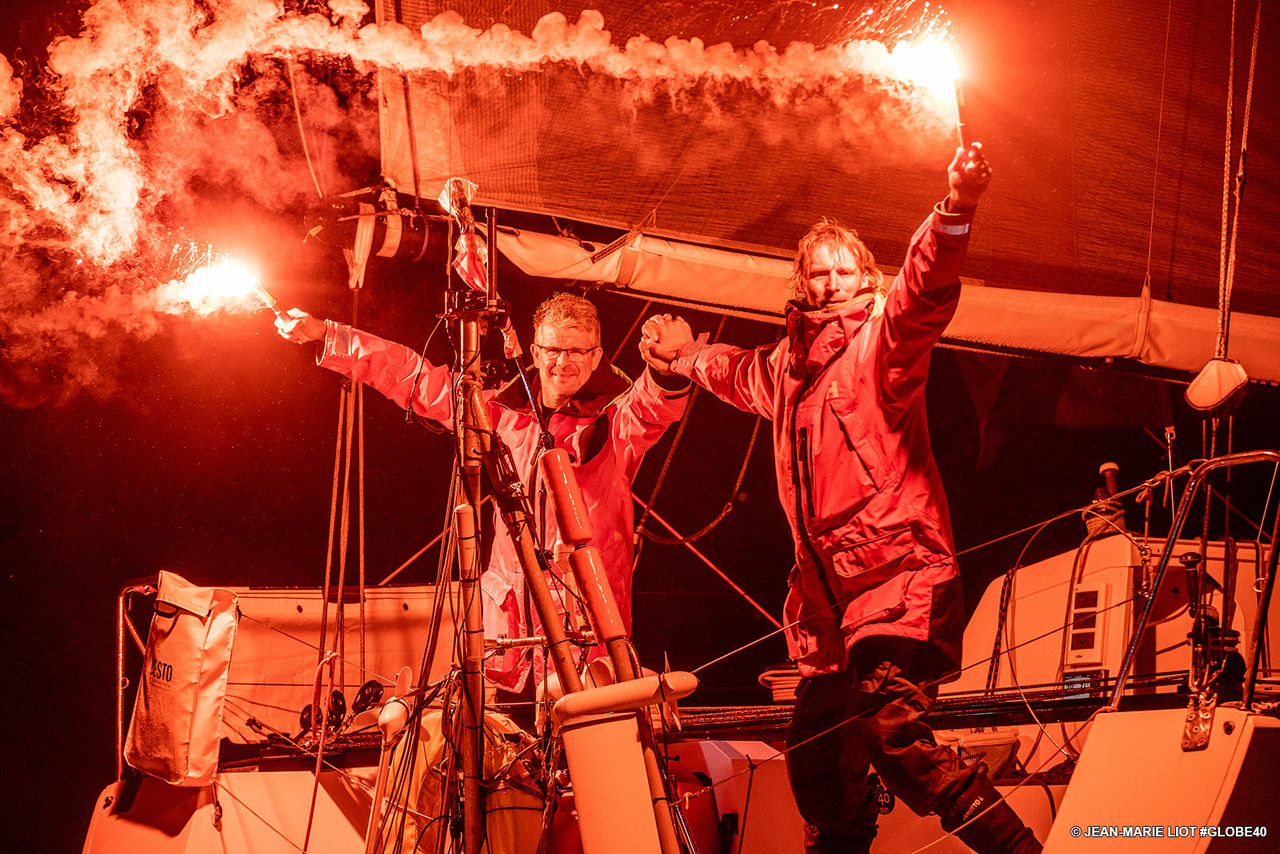
Banderas Bay Regatta Turns 30 in Perfect Conditions
Banderas Bay offered up perfect conditions for all three days (plus a practice day and five fiestas) at the 30th Banderas Bay Regatta last week. Vallarta Yacht Club, next door to the Paradise Village Resort and Marina in Riviera Nayarit, hosts the event for cruisers to get them to try racing — but it’s a can’t-miss regatta for some pretty serious racers too.

A Few Faces in the Crowd
While we were there for the regatta, we ran into many old friends from the Bay Area and beyond, and made new ones. It’s literally an international regatta (Regata Internacional Bahía de Banderas). The sailors hail from the US, Mexico, Canada, Europe and Asia.



Vallarta YC turns 21 this year (just old enough to order a margarita in its own cantina). So it’s actually younger than the regatta it hosts. And BBR is just one of many first-class events, including world championships, that the club puts on. Dick Markie, harbormaster at Paradise Village, says they run 90 days’ worth of racing each year. (It’s mostly dinghies during the summer. The snow birds start to fly north in mid-April.) The afternoon beer can season runs January through March.
Those Perfect Banderas Bay Conditions?

Those perfect winter conditions? Air temperature hitting highs in the low to mid-80s, water temperature similar to that of the swimming pools, and an afternoon breeze you can set your clock by. During the week of the regatta, the westerly ranged from mid-teens to low 20s. On the bigger-breeze days, whitecaps frothed up, but we didn’t get the steep chop that can be so unpleasant on San Francisco Bay. Banderas Bay more closely resembles Monterey Bay, with a wide-open mouth and headlands spaced far apart to the north (Punta Mita) and south (Yelapa), with Puerto Vallarta right in the middle.


We’ll have much more on the racing, including photos of the division winners, in the April issue of Latitude 38, coming out on March 31. In the meantime, surf on over to www.banderasbayregatta.com.
Whatever the Weather, the Spring Equinox Has Arrived
Hooray for spring! Yes, it’s still raining, and yes, the snow is still falling, but that’s only temporary. Eventually, the weather will catch up with the season and we’ll start to see more sunny days and higher temperatures (we hope). And with the sunnier, warmer days come more daylight hours, which in turn means more sailing hours. We already “gained” an hour last week, and we’re looking forward to more!
In the meantime, did you know that the actual date of the equinox varies from year to year between March 19 and 21? Of course you did. But here’s something you may not know. According to Timeanddate.com, the last time the equinox fell on March 21 (yes, we realize today is March 20; bear with us) was 2007. The next time it falls on 3/21 will be in the year 2101. So we hope you enjoyed it last time, because we can be sure none of us here today will be around the next time it happens.

Here’s another fun fact: This experiment, shared by Timeanddate.com, can only be done on the March or September equinox:
“To do this experiment, you’ll need a straight stick or a long wooden ruler, a protractor and a compass.
“Find an empty space such as a park or a parking lot where there are few tall buildings, trees or hills to obstruct the Sun. Find your location’s latitude. Subtract this number from 90. This will be the angle you will affix the stick in the ground.
“If you are in the Northern Hemisphere, use your compass to find south and point the stick in that direction. If you’re in the Southern Hemisphere, point the stick or the ruler to the north. Using the protractor fix the stick in the ground at the angle you just calculated — remember to point it in the direction opposite to the hemisphere you are in.
“Wait till noon and see the shadow of the stick disappear. At noon, the stick will have no shadow at all!”
And one more… the precise time of today’s equinox, in the Bay Area, is 2:24 p.m.
By the way, as we’re talking about longer days and more sailing, here’s another fun fact. There are now only three months until the start of summer, and only three months until the annual Summer Sailstice International Celebration of Sailing. This year’s Summer Sailstice falls on June 24, the Saturday closest to the Northern Hemisphere’s summer solstice on June 21.

It’s only 12 weeks. Time flies when you’re having fun, so make sure you’re flying with it and register your Summer Sailstice sailing plans now.
Support Cal Maritime Through Yacht Donation
Yacht donations are vitally important to supporting our students and programs. More info: cmafyachtdonation.org.
There Are Some Dangers to the Baja Ha-Ha
There is always the possibility, although unlikely, of very strong winds or big seas.

But there are also possible domestic dangers. We’ve lost count of how many Ha-Ha participants have met their marriage partners on the Ha-Ha.
Then there are conceptions. Zac Singer and Karina Velasco, #1 entry in last year’s Baja Ha-Ha with the Andrews 56 Encore, announced they are expecting, based on certain behavior during the event. While this wasn’t a first, we offer them the warmest congratulations.
Kids are the greatest!
The Ocean Race Fleet Nears Cape Horn Only Minutes Apart
In the very early stages of this third leg of The Ocean Race, the racing looked like a bust. Holcim PRB was flying along at the front with a dominant lead while one boat was returning to port, one was making repairs to the top of their mast, and the other two were licking their wounds at reduced speeds after a brutal start. Unless Holcim PRB faltered, it seemed a foregone conclusion that they had the speed and the early advantage to simply cruise to victory in what is the longest leg in Ocean Race history. Half a month and several thousand miles of sailing later, however, the game has changed significantly, as the entire four-boat fleet is now sailing within sight of one another on their way to Cape Horn.
After pulling out to a lead of more than 600 miles at one point, Holcim PRB ran into light air up ahead, while their rivals brought in the breeze from behind. By the time they were passing Cape Leeuwin, Australia, their lead had diminished to just north of a hundred miles, a gap they would sustain until reaching the longitude of New Zealand. First through the scoring gate just west of Tasmania, Holcim PRB would collect another five points on the scoreboard and keep their scorecard perfect thus far. Malizia, 11th Hour Racing and Biotherm would cross the scoring gate in second, third and fourth, respectively. Just over 2,500 nautical miles to Cape Horn as of this writing, the fleet of four foiling IMOCAs should round the Cape in roughly a week’s time before pointing their bows north and racing another 1,800 nautical miles to Itajai, Brazil.

In addition to earning five valuable points near Tasmania, Holcim PRB added another nice feather to their cap when they set an IMOCA class 24-hour record of 595.26 nautical miles. When the fleet encountered a 600-mile runway of brisk northerlies and relatively flat water just before the scoring gate, they barreled along eastward with the 24-hour record falling repeatedly before the final mark was set. Once east of New Zealand, the fleet of four IMOCAs has again been compressed by uncharacteristically light winds in this part of the world. With the foiling IMOCAs thriving in the relatively light and smooth conditions, however, they can still put up huge numbers and are routinely crossing the 500-mile-per-day barrier, even in suboptimal speed conditions.The forecast looks relatively benign for the next couple of days, though the fleet should see a healthy low-pressure system and its associated westerly and northwesterly winds as they approach the Cape toward the end of the week and into the weekend.

Conversely, GUYOT Environment retired from this leg to undergo repairs in Cape Town due to the discovery of delamination in the hull. The boat is currently in delivery to Brazil for the next leg.
Back in France, the equally diminished fleet of four Class 40s have concluded their doublehanded round-the-world race in the inaugural Globe 40 race. American entry AMHAS, from Portland, Maine, won the final leg from Grenada to Lorient, France. With competitors claiming to have seen their most difficult sailing conditions of the entire race — just before the finish — the fleet sailed through a North Atlantic depression with up to 60 knots of breeze. Holland’s Frans Budel and Ysbrand Endt on Sec Hayai finished second in the final leg to secure overall victory in this new race, which seems sure to pick up momentum for future editions.

Use the Map to Get Lost at Copperfield’s Books
Like a good book or magazine, sailing is a great escape. Getting lost in the pages of a great book or great stories in a magazine can transport you from a frenetic world to the serenity or adventure of the high seas. And you can find it as close to home as Copperfield’s Books at 1200 Fourth St. in San Rafael. Copies of the best sailing magazine, Latitude 38, are right by the front door near their magazine rack, brimming with great titles.

We stopped by on Saturday, when the store was packed with readers, parents, kids and many others looking to get lost in the pages of a good read.

You can also find Latitude 38 at Book Passage in Corte Madera, Sausalito Books by the Bay next door to Marotta Yachts (which also has magazines) in Sausalito, at the Sausalito and Tiburon libraries, and Builder’s Book Source on Fourth Street in Berkeley. Of course, all your favorite waterfront haunts have them, too — your harbormaster’s office, yacht club, sailmaker and, hopefully, anywhere West Coast sailors gather. If you have a suggestion of where we can distribute magazines, send an email here.

The current March 2023 issue has stories on David Crosby and Mayan, Bill Erkelens, the Three Bridge Fiasco, Youth Sailing by Heather Breaux, cruising in the South Pacific and much more.
Yes, the whole magazine is available to read online, but as good as it is, it’s just not the same as holding a copy in your hands. The magazine looks much better on a coffee table than an iPad, and having a real magazine is much closer to having the mainsheet in your teeth and the tiller in your hand.
Our distribution map will help you get “lost” in the pages of a book or magazine. We hope you can use our map to get lost today.


